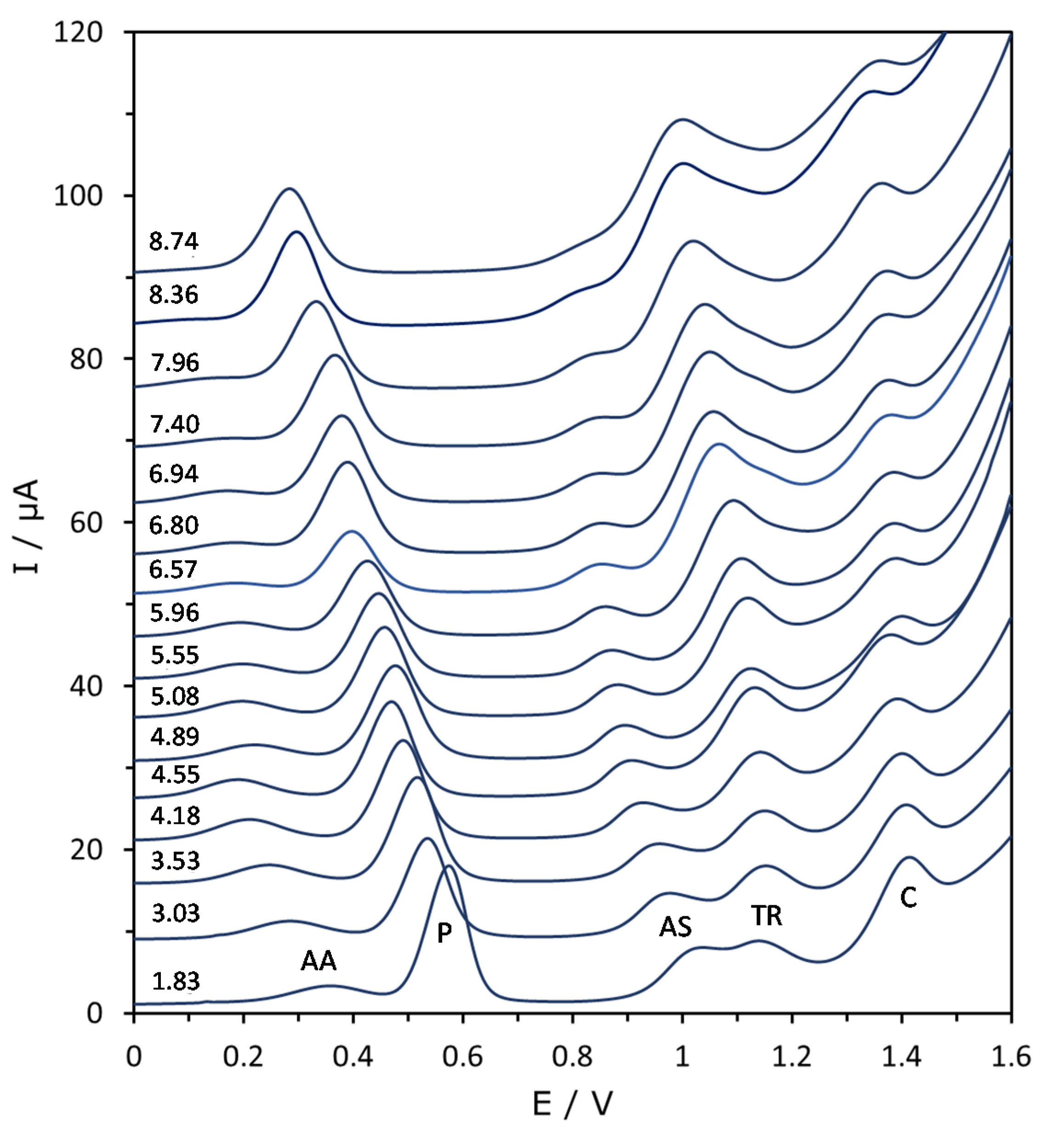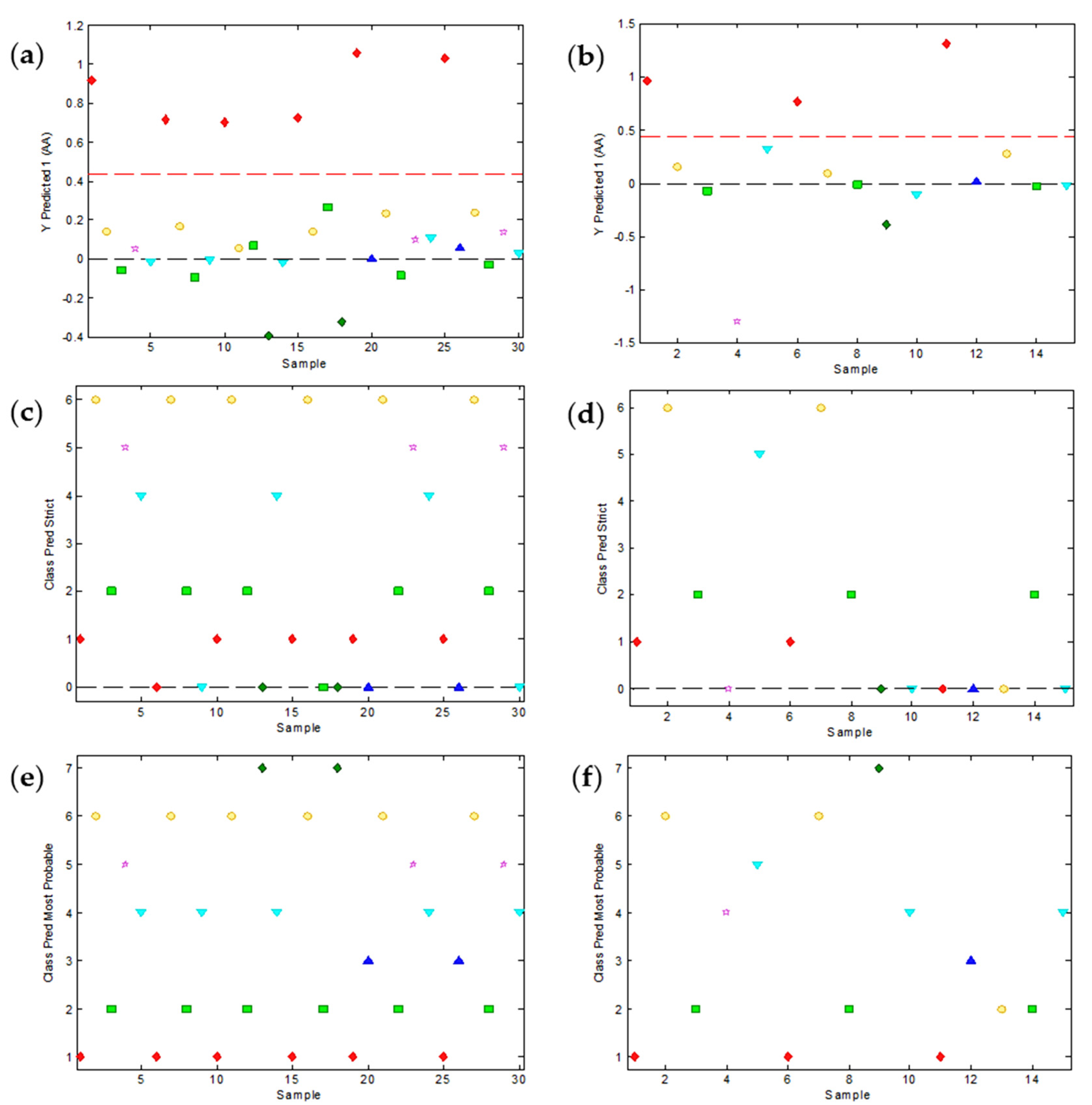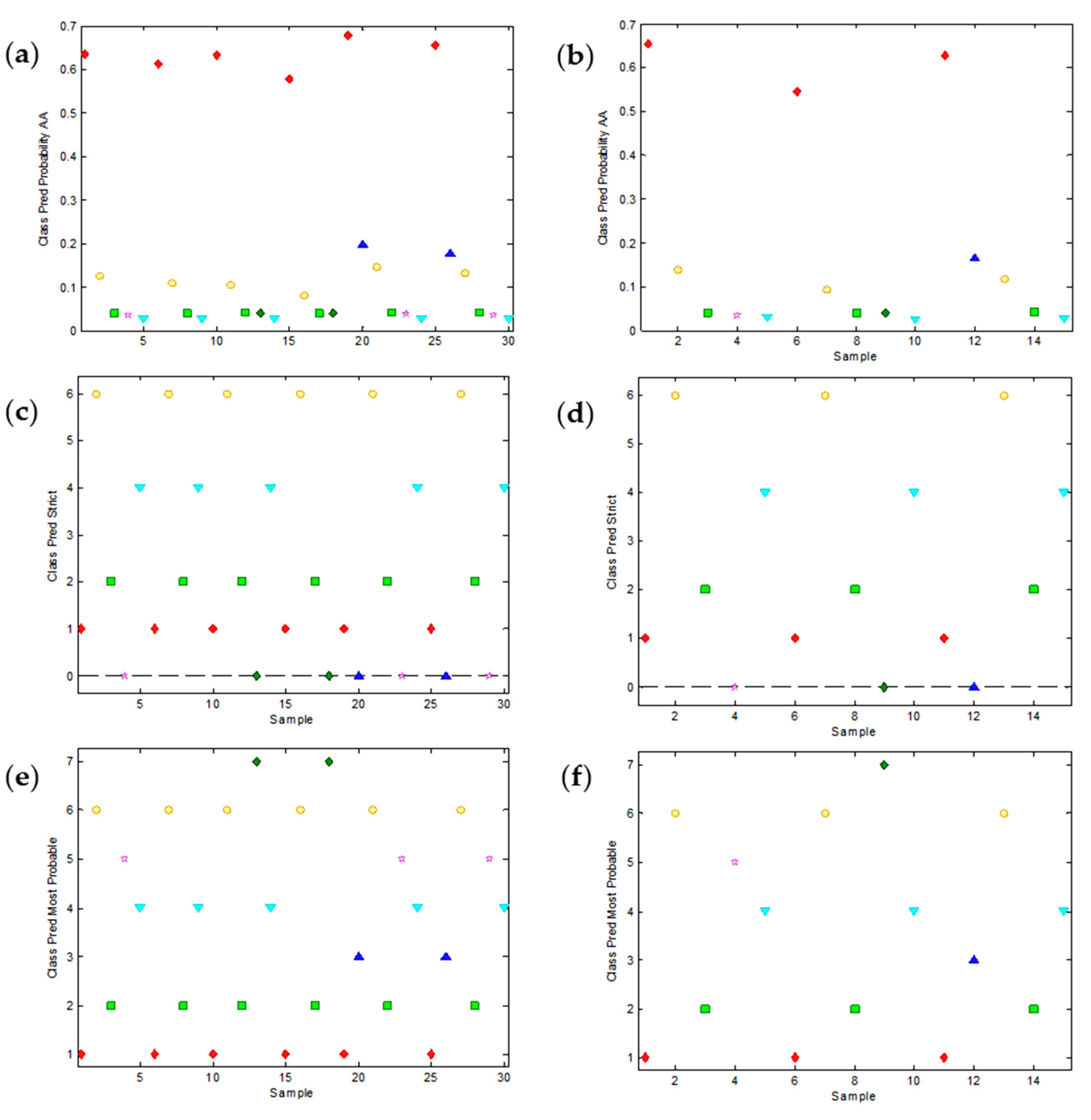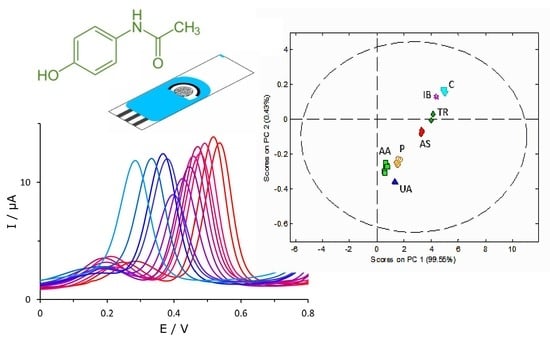A Chemometric Survey about the Ability of Voltammetry to Discriminate Pharmaceutical Products from the Evolution of Signals as a Function of pH
Abstract
1. Introduction
2. Materials and Methods
2.1. Chemicals
2.2. Apparatus
2.3. Voltammetric Measurements
2.4. Data Treatment
3. Results and Discussion
3.1. Preliminary Study
3.2. Discrimination of Peaks from Their Evolution with pH
4. Conclusions
Author Contributions
Funding
Acknowledgments
Conflicts of Interest
References
- World Health Organization. Pharmaceuticals in Drinking-Water; World Health Organization: Geneva, Switzerland, 2011. [Google Scholar]
- Fatta-Kassinos, D.; Meric, S.; Nikolaou, A. Pharmaceutical residues in environmental waters and wastewater: Current state of knowledge and future research. Anal. Bioanal. Chem. 2011, 399, 251–275. [Google Scholar] [CrossRef] [PubMed]
- Verlicchi, P.; Al Aukidy, M.; Zambello, E. Occurrence of pharmaceutical compounds in urban wastewater: Removal, mass load and environmental risk after a secondary treatment—A review. Sci. Total Environ. 2012, 429, 123–155. [Google Scholar] [CrossRef]
- Rivera-Utrilla, J.; Sánchez-Polo, M.; Ferro-García, M.A.; Prados-Joya, G.; Ocampo-Pérez, R. Pharmaceuticals as emerging contaminants and their removal from water. A review. Chemosphere 2013, 93, 1268–1287. [Google Scholar] [CrossRef] [PubMed]
- Rehman, M.S.U.; Rashid, N.; Ashfaq, M.; Saif, A.; Ahmad, N.; Han, J.I. Global risk of pharmaceutical contamination from highly populated developing countries. Chemosphere 2015, 138, 1045–1055. [Google Scholar] [CrossRef] [PubMed]
- Yang, Y.; Ok, Y.S.; Kim, K.H.; Kwon, E.E.; Tsang, Y.F. Occurrences and removal of pharmaceuticals and personal care products (PPCPs) in drinking water and water/sewage treatment plants: A review. Sci. Total Environ. 2017, 596, 303–320. [Google Scholar] [CrossRef]
- Mandaric, L.; Diamantini, E.; Stella, E.; Cano-Paoli, K.; Valle-Sistac, J.; Molins-Delgado, D.; Bellin, A.; Chiogna, G.; Majone, B.; Diaz-Cruz, M.S.; et al. Contamination sources and distribution patterns of pharmaceuticals and personal care products in Alpine rivers strongly affected by tourism. Sci. Total Environ. 2017, 590, 484–494. [Google Scholar] [CrossRef]
- Kantiani, L.; Llorca, M.; Sanchís, J.; Farré, M.; Barceló, D. Emerging food contaminants: A review. Anal. Bioanal. Chem. 2010, 398, 2413–2427. [Google Scholar] [CrossRef]
- Wilkinson, J.L.; Hooda, P.S.; Barker, J. Ecotoxic pharmaceuticals, personal care products, and other emerging contaminants: A review of environmental, receptor-mediated, developmental, and epigenetic toxicity with discussion of proposed toxicity to humans. Crit. Rev. Environ. Sci. Technol. 2016, 46, 336–381. [Google Scholar] [CrossRef]
- Jurado, A.; Walther, M.; Díaz-Cruz, M.S. Occurrence, fate and environmental risk assessment of the organic microcontaminants included in the Watch Lists set by EU Decisions 2015/495 and 2018/840 in the groundwater of Spain. Sci. Total Environ. 2019, 663, 285–296. [Google Scholar] [CrossRef]
- Commission Implementing Decision (EU) 2015/495 of 20 March 2015 Establishing a Watch List of Substances for Union-Wide Monitoring in the Field of Water Policy Pursuant to Directive 2008/105/EC of the European Parliament and of the Council. Available online: https://eur-lex.europa.eu/legal-content/EN/ALL/?uri=CELEX%3A32015D0495 (accessed on 6 May 2020).
- Petrovic, M.; Hernando, M.D.; Díaz-Cruz, M.S.; Barceló, D. Liquid chromatography-tandem mass spectrometry for the analysis of pharmaceutical residues in environmental samples: A review. J. Chromatogr. A 2005, 1067, 1–14. [Google Scholar] [CrossRef]
- Buchberger, W.W. Current approaches to trace analysis of pharmaceuticals and personal care products in the environment. J. Chromatog. A 2011, 1218, 603–618. [Google Scholar] [CrossRef] [PubMed]
- Patrolecco, L.; Ademollo, N.; Grenni, P.; Tolomei, A.; Caracciolo, A.B.; Capri, S. Simultaneous determination of human pharmaceuticals in water samples by solid phase extraction and HPLC with UV-fluorescence detection. Microchem. J. 2013, 107, 165–171. [Google Scholar] [CrossRef]
- Kim, C.; Ryu, H.D.; Chung, E.G.; Kim, Y.; Lee, J.K. A review of analytical procedures for the simultaneous determination of medically important veterinary antibiotics in environmental water: Sample preparation, liquid chromatography, and mass spectrometry. J. Environ. Manag. 2018, 217, 629–645. [Google Scholar] [CrossRef] [PubMed]
- Gupta, V.K.; Jain, R.; Radhapyari, K.; Jadon, N.; Agarwal, S. Voltammetric techniques for the assay of pharmaceuticals—A review. Anal. Biochem. 2011, 408, 179–196. [Google Scholar] [CrossRef] [PubMed]
- Amiri-Aref, M.; Raoof, J.B.; Ojani, R. A highly sensitive electrochemical sensor for simultaneous voltammetric determination of noradrenaline, acetaminophen, xanthine and caffeine based on a flavonoid nanostructured modified glassy carbon electrode. Sens. Actuators B Chem. 2014, 192, 634–641. [Google Scholar] [CrossRef]
- Cernat, A.; Tertiş, M.; Săndulescu, R.; Bedioui, F.; Cristea, A.; Cristea, C. Electrochemical sensors based on carbon nanomaterials for acetaminophen detection: A review. Anal. Chim. Acta 2015, 886, 16–28. [Google Scholar] [CrossRef]
- Li, M.; Li, Y.T.; Li, D.W.; Long, Y.T. Recent developments and applications of screen-printed electrodes in environmental assays—A review. Anal. Chim. Acta 2012, 734, 31–44. [Google Scholar] [CrossRef] [PubMed]
- Couto, R.A.S.; Lima, J.L.F.C.; Quinaz, M.B. Recent developments, characteristics and potential applications of screen-printed electrodes in pharmaceutical and biological analysis. Talanta 2016, 146, 801–814. [Google Scholar] [CrossRef]
- Mohamed, H.M. Screen-printed disposable electrodes: Pharmaceutical applications and recent developments. Trends Anal. Chem. 2016, 82, 1–11. [Google Scholar] [CrossRef]
- Rahi, A.; Karimian, K.; Heli, H. Nanostructured materials in electroanalysis of pharmaceuticals. Anal. Biochem. 2016, 497, 39–47. [Google Scholar] [CrossRef]
- Serrano, N.; Castilla, O.; Ariño, C.; Diaz-Cruz, M.S.; Díaz-Cruz, J.M. Commercial screen-printed electrodes based on carbon nanomaterials for a fast and cost-effective voltammetric determination of paracetamol, ibuprofen and caffeine in water samples. Sensors 2019, 19, 4039. [Google Scholar] [CrossRef]
- Khairy, M.; Khorshed, A.A.; Rashwan, F.A.; Salah, G.A.; Abdel-Wadood, H.M.; Banks, C.E. Simultaneous voltammetric determination of antihypertensive drugs nifedipine and atenolol utilizing MgO nanoplatelet modified screen-printed electrodes in pharmaceuticals and human fluids. Sens. Actuators B Chem. 2017, 252, 1045–1054. [Google Scholar] [CrossRef]
- Zhang, Y.; Jiang, X.; Zhang, J.; Zhang, H.; Li, Y. Simultaneous voltammetric determination of acetaminophen and isoniazid using MXene modified screen-printed electrode. Biosens. Bioelectron. 2019, 130, 315–321. [Google Scholar] [CrossRef] [PubMed]
- Ortiz-Aguayo, D.; Bonet-San-Emeterio, M.; del Valle, M. Simultaneous voltammetric determination of acetaminophen, ascorbic acid and uric acid by use of integrated array of screen-printed electrodes and chemometric tools. Sensors 2019, 19, 3286. [Google Scholar] [CrossRef] [PubMed]
- Slattery, S.J.; Blaho, J.K.; Lehnes, J.; Goldsby, K.A. pH-Dependent metal-based redox couples as models for proton-coupled electron transfer reactions. Coord. Chem. Rev. 1998, 174, 391. [Google Scholar] [CrossRef]
- Stumm, W.; Morgan, J.J. Aquatic Chemistry, 2nd ed.; Wiley: New York, NY, USA, 1981; Chapter 7. [Google Scholar]
- Heyrovsky, J.; Kuta, J. Principles of Polarography; Academic Press: New York, NY, USA, 1966; p. 161. [Google Scholar]
- Brown, S.; Tauler, R.; Walczak, B. (Eds.) Comprehensive Chemometrics; Elsevier: Oxford, UK, 2009. [Google Scholar]
- Díaz-Cruz, J.M.; Esteban, M.; Ariño, C. Chemometrics in Electroanalysis; Inside ‘Monographs in Electrochemistry’; Scholz, F., Ed.; Springer Nature: Cham, Switzerland, 2019. [Google Scholar] [CrossRef]
- Alberich, A.; Díaz-Cruz, J.M.; Ariño, C.; Esteban, M. Potential shift correction in multivariate curve resolution of voltammetric data. General formulation and application to some experimental systems. Analyst 2008, 133, 112–125. [Google Scholar] [CrossRef] [PubMed]
- Alberich, A.; Díaz-Cruz, J.M.; Ariño, C.; Esteban, M. Combined use of the potential shift correction and the simultaneous treatment of spectroscopic and electrochemical data by multivariate curve resolution: Analysis of a Pb(II)-phytochelatin system. Analyst 2008, 133, 470–477. [Google Scholar] [CrossRef]
- Díaz-Cruz, J.M.; Sanchís, J.; Chekmeneva, E.; Ariño, C.; Esteban, M. Non-linear multivariate curve resolution analysis of voltammetric pH titrations. Analyst 2010, 135, 1653–1662. [Google Scholar] [CrossRef]
- Office of Dietary Supplements, US National Institutes of Health. Fact Sheet for Health Professionals—Vitamin C. Available online: https://ods.od.nih.gov/factsheets/VitaminC-HealthProfessional (accessed on 27 May 2020).
- Kaur, H.; Halliwell, B. Action of biologically-relevant oxidizing species upon uric acid. Identification of uric acid oxidation products. Chem. Biol. Interact. 1990, 73, 235–247. [Google Scholar] [CrossRef]
- Brunton, L.L.; Lazo, J.S.; Parker, K.L. Goodman & Gilman’s the Pharmacological Basis of Therapeutics, 11th ed.; Mc Graw Hill: New York, NY, USA, 2006. [Google Scholar]
- Aspirin. AHFS DI Monographs of the American Society of Health-System Pharmacists. Available online: https://www.drugs.com/monograph/aspirin.html (accessed on 27 May 2020).
- Trimethoprim. AHFS DI Monographs of the American Society of Health-System Pharmacists. Available online: https://www.drugs.com/monograph/trimethoprim.html (accessed on 27 May 2020).
- Brereton, R.G.; Lloyd, G.R. Support vector machines for classification and regression. Analyst 2010, 135, 230–267. [Google Scholar] [CrossRef]
- Luts, J.; Ojeda, F.; van de Plas, R.; de Moor, B.; van Huffel, S.; Suykens, J.A. A tutorial on support vector machine-based methods for classification problems in chemometrics. Anal. Chim. Acta 2010, 665, 129–145. [Google Scholar] [CrossRef] [PubMed]
- Nguyen, L. Tutorial on support vector machine. Appl. Comput. Math. 2017, 6, 1–15. [Google Scholar] [CrossRef]
- Matlab, version R2009b ed.; Mathworks Inc.: Natick, MA, USA, 2009.
- PLS Toolbox Version 7.8.2; Eigenvector Research Inc.: Wenatchee, WA, USA, 2014.






| Method | Data | Parameter | AA | UA | P | AS | TR | IB | C | Overall Strict | Most Probable |
|---|---|---|---|---|---|---|---|---|---|---|---|
| PLS-DA | Cal. | Sensitivity | 1.00 | 1.00 | 1.00 | 0.83 | 1.00 | 1.00 | 1.00 | - | - |
| Specificity | 1.00 | 1.00 | 0.83 | 0.79 | 1.00 | 1.00 | 1.00 | - | - | ||
| Class. error (%) | 0.0 | 0.0 | 13.3 | 20.0 | 0.0 | 0.0 | 0.0 | 26.7 | 0.0 | ||
| RMSEC 1 | 0.167 | 0.211 | 0.329 | 0.316 | 0.204 | 0.225 | 0.257 | - | - | ||
| Bias | −0.003 | 0.006 | −0.007 | 0.004 | 0.001 | −0.002 | 0.002 | - | - | ||
| R2 | 0.825 | 0.285 | 0.326 | 0.377 | 0.329 | 0.152 | 0.244 | - | - | ||
| Val. | Sensitivity | 1.00 | 1.00 | 0.67 | 1.00 | 1.00 | 0.00 | 0.67 | - | - | |
| Specificity | 1.00 | 0.93 | 0.75 | 0.67 | 1.00 | 0.86 | 0.92 | - | - | ||
| Class. error (%) | 0.00 | 3.30 | 26.70 | 26.70 | 0.00 | 20.00 | 13.30 | 46.7 | 20.0 | ||
| RMSEP 2 | 0.385 | 0.226 | 0.352 | 0.567 | 0.203 | 0.443 | 0.361 | - | - | ||
| Bias | −0.069 | 0.023 | −0.011 | 0.072 | −0.002 | −0.004 | −0.009 | - | - | ||
| R2 | 0.580 | 0.207 | 0.241 | 0.069 | 0.005 | 0.267 | 0.294 | - | - | ||
| SVM-DA | Cal. | Sensitivity | 1.00 | 1.00 | 1.00 | 1.00 | 1.00 | 1.00 | 1.00 | - | - |
| Specificity | 1.00 | 1.00 | 1.00 | 1.00 | 1.00 | 1.00 | 1.00 | - | - | ||
| Class. error (%) | 0.0 | 0.0 | 0.0 | 0.0 | 0.0 | 0.0 | 0.0 | 23.3 | 0.0 | ||
| Val. | Sensitivity | 1.00 | 1.00 | 1.00 | 1.00 | 1.00 | 1.00 | 0.67 | - | - | |
| Specificity | 1.00 | 1.00 | 1.00 | 1.00 | 1.00 | 0.93 | 1.00 | - | - | ||
| Class. error (%) | 0.00 | 0.00 | 0.00 | 0.00 | 0.00 | 3.60 | 16.70 | 20.0 | 0.0 |
© 2020 by the authors. Licensee MDPI, Basel, Switzerland. This article is an open access article distributed under the terms and conditions of the Creative Commons Attribution (CC BY) license (http://creativecommons.org/licenses/by/4.0/).
Share and Cite
Marín, J.; Serrano, N.; Ariño, C.; Díaz-Cruz, J.M. A Chemometric Survey about the Ability of Voltammetry to Discriminate Pharmaceutical Products from the Evolution of Signals as a Function of pH. Chemosensors 2020, 8, 46. https://doi.org/10.3390/chemosensors8030046
Marín J, Serrano N, Ariño C, Díaz-Cruz JM. A Chemometric Survey about the Ability of Voltammetry to Discriminate Pharmaceutical Products from the Evolution of Signals as a Function of pH. Chemosensors. 2020; 8(3):46. https://doi.org/10.3390/chemosensors8030046
Chicago/Turabian StyleMarín, Javier, Núria Serrano, Cristina Ariño, and José Manuel Díaz-Cruz. 2020. "A Chemometric Survey about the Ability of Voltammetry to Discriminate Pharmaceutical Products from the Evolution of Signals as a Function of pH" Chemosensors 8, no. 3: 46. https://doi.org/10.3390/chemosensors8030046
APA StyleMarín, J., Serrano, N., Ariño, C., & Díaz-Cruz, J. M. (2020). A Chemometric Survey about the Ability of Voltammetry to Discriminate Pharmaceutical Products from the Evolution of Signals as a Function of pH. Chemosensors, 8(3), 46. https://doi.org/10.3390/chemosensors8030046









